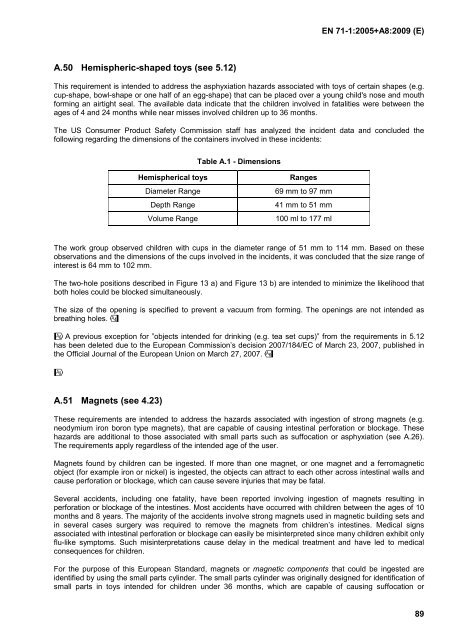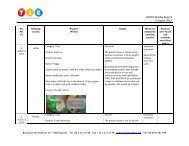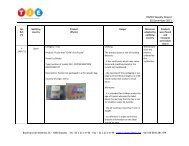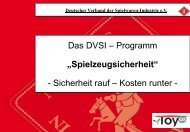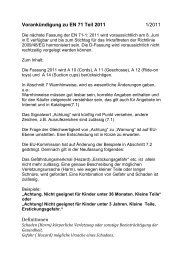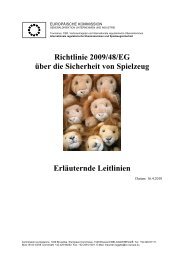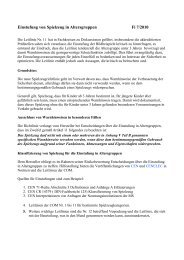You also want an ePaper? Increase the reach of your titles
YUMPU automatically turns print PDFs into web optimized ePapers that Google loves.
A.50 Hemispheric-shaped toys (see 5.12)<br />
<strong>EN</strong> <strong>71</strong>-1:<strong>2005+</strong><strong>A8</strong>:2009 (E)<br />
This requirement is intended to address the asphyxiation hazards associated with toys of certain shapes (e.g.<br />
cup-shape, bowl-shape or one half of an egg-shape) that can be placed over a young child's nose and mouth<br />
forming an airtight seal. The available data indicate that the children involved in fatalities were between the<br />
ages of 4 and 24 months while near misses involved children up to 36 months.<br />
The US Consumer Product Safety Commission staff has analyzed the incident data and concluded the<br />
following regarding the dimensions of the containers involved in these incidents:<br />
Table A.1 - Dimensions<br />
Hemispherical toys Ranges<br />
Diameter Range 69 mm to 97 mm<br />
Depth Range 41 mm to 51 mm<br />
Volume Range 100 ml to 177 ml<br />
The work group observed children with cups in the diameter range of 51 mm to 114 mm. Based on these<br />
observations and the dimensions of the cups involved in the incidents, it was concluded that the size range of<br />
interest is 64 mm to 102 mm.<br />
The two-hole positions described in Figure 13 a) and Figure 13 b) are intended to minimize the likelihood that<br />
both holes could be blocked simultaneously.<br />
The size of the opening is specified to prevent a vacuum from forming. The openings are not intended as<br />
breathing holes.(<br />
+A previous exception for ”objects intended for drinking (e.g. tea set cups)” from the requirements in 5.12<br />
has been deleted due to the European Commission’s decision 2007/184/EC of March 23, 2007, published in<br />
the Official Journal of the European Union on March 27, 2007.,<br />
/<br />
A.51 Magnets (see 4.23)<br />
These requirements are intended to address the hazards associated with ingestion of strong magnets (e.g.<br />
neodymium iron boron type magnets), that are capable of causing intestinal perforation or blockage. These<br />
hazards are additional to those associated with small parts such as suffocation or asphyxiation (see A.26).<br />
The requirements apply regardless of the intended age of the user.<br />
Magnets found by children can be ingested. If more than one magnet, or one magnet and a ferromagnetic<br />
object (for example iron or nickel) is ingested, the objects can attract to each other across intestinal walls and<br />
cause perforation or blockage, which can cause severe injuries that may be fatal.<br />
Several accidents, including one fatality, have been reported involving ingestion of magnets resulting in<br />
perforation or blockage of the intestines. Most accidents have occurred with children between the ages of 10<br />
months and 8 years. The majority of the accidents involve strong magnets used in magnetic building sets and<br />
in several cases surgery was required to remove the magnets from children’s intestines. Medical signs<br />
associated with intestinal perforation or blockage can easily be misinterpreted since many children exhibit only<br />
flu-like symptoms. Such misinterpretations cause delay in the medical treatment and have led to medical<br />
consequences for children.<br />
For the purpose of this European Standard, magnets or magnetic components that could be ingested are<br />
identified by using the small parts cylinder. The small parts cylinder was originally designed for identification of<br />
small parts in toys intended for children under 36 months, which are capable of causing suffocation or<br />
89


